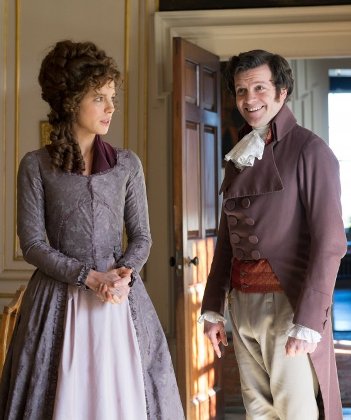Lockhart (Dane DeHaan), a young, unethical businessman, is sent to a mysterious Swiss wellness center to retrieve his company’s CEO, but a car accident lands him as a patient. While the institute’s director (Jason Isaacs) expounds on the wonders of his water cures, Lockhart finds that everything about the place is a little off and mysteries abound. The patients, he discovers, never leave, and that includes the only other youthful one, Hannah (Mia Goth), who is encircled by even greater mysteries.
Because he is best known for a pop trilogy (The Pirates of the Caribbean), people tend to miss that director Gore Verbinski is a master of composition. That’s why those films are so successful. Yes, yes, Johnny Depp was hysterical, but just look at the film. Look at the framing and the lighting and the intricate and perfectly chosen colors, and how the camera pans and where the shot pauses and where it zips along and how that movement relates to the movement of characters and ships and what those characters are thinking. I don’t think a living director does it better. Which would make Verbinski the best director alive… if making a film didn’t involve anything else. But it does and Verbinski is better at the moments than the whole. Still, he does some pretty interesting things with those moments.
Many film critics have their film history wrong, trying to make A Cure For Wellness an homage to the Universal horror films of the ’30 and ‘40s, as it is clearly pointing backward to something. But it has absolutely nothing to do with those movies. Frankenstein and Dracula were firmly rooted in a kind of reality and in a plot-driven cinematic storytelling tradition.
A Cure For Wellness instead owes its nature to the Italian dreamscape horror of the 1960s and ‘70s, such as Operazione paura, where story is nice, but gothic impressions are far more important, or the colorful Suspiria where tension and atmosphere are king. Everything is beautiful and everything is odd. The background is glorious mountains which juxtapose nicely with the early industrial water tanks. At times the institute is spotless and other times it reeks of infection. But the strangeness doesn’t start after Lockhart leaves civilization. The world it twisted from the start, which puts A Cure For Wellness somewhere between a satire and a fairytale. Everyone we meet in New York is either a vicious bastard or a broken soul, but no one is happy. Thus, their wellness is in need of a cure, though not what is offered in the Swiss alps. So we slip from unpleasant dream to full on nightmare.
The last half hour still hangs to its Suspiria feel, but adds in another thread of old European cult films–call it trash cinema, but in the very best way. A Cure For Wellness dives in to the sensational and revolting in a way I found refreshing. We go from hypnotic and bizarre to lurid and… well, still bizarre, but the nightmare feeling vanishes as we wake up with answers to all the questions. The answers are not completely satisfying, and leave some substantial holes, but it was time to clear away the cobwebs.
And therein lies the problem with the film. At two and a half hours, it is easily thirty minutes too long. It needed a concrete ending because it was getting tiring. Dream stories need to be told quicker. With little to hang on to and a feeling of repeatedly starting over again, the nightmare became a bog. And Lockhart doesn’t help. He’s unlikable from the start and he’s all we get as a portal. A creep like him is fine in a briefer picture or one where we are following other things, but with nothing else to connect to, he’s the wrong protagonist.
Jason Isaacs mashes together sympathy and buried evil while Mia Goth personifies loss and need and the unknown. Add in that atmosphere and the macabre beauty and A Cure For Wellness is a picture to see, but there is a far better film that could easily be carved out of this one.




 Love and Friendship is a Jane Austin film. For those who don’t read or watch Austin (shame on you), she can be quite pointed. But her jabs tend to be done with a bit of affection. Society is dumb and the people in it shallow and silly, but society is beautiful as well and those shallow silly people have good hearts. Not so here. This is Austin with the gloves off and in full comedy mode.
Love and Friendship is a Jane Austin film. For those who don’t read or watch Austin (shame on you), she can be quite pointed. But her jabs tend to be done with a bit of affection. Society is dumb and the people in it shallow and silly, but society is beautiful as well and those shallow silly people have good hearts. Not so here. This is Austin with the gloves off and in full comedy mode.




